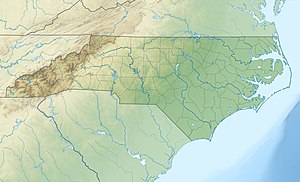Yadkin Valley
| Yadkin River | |
|---|---|
 The Yadkin River at Elkin, North Carolina, in 2011.
| |
 The Yadkin River is the northernmost part of the Pee Dee Drainage Basin.
| |
| Country | United States |
| State | North Carolina |
| Physical characteristics | |
| Main source |
Watauga County near Blowing Rock 36°08′39″N 81°37′45″W / 36.1442958°N 81.6292711°W |
| River mouth |
Confluence with the Uwharrie River, forming the Pee Dee River 4 miles (6.4 km) southeast of Badin 35°22′51″N 80°03′35″W / 35.3806969°N 80.0597749°W |
| Basin features | |
| Progression | Yadkin River → Pee Dee River → Atlantic Ocean |
| River system | Yadkin–Pee Dee River Basin |
| Waterbodies | W. Kerr Scott Reservoir, High Rock Lake, Tuckertown Reservoir, Badin Lake, Falls Reservoir |
| GNIS | 1024415 |
The Yadkin River is one of the longest rivers in North Carolina, flowing 215 miles (346 km). It rises in the northwestern portion of the state near the Blue Ridge Parkway's Thunder Hill Overlook. Several parts of the river are impounded by dams for water, power, and flood control. The river becomes the Pee Dee River at the confluence of the Uwharrie River south of the community of Badin, NC and east of the town of Albemarle, NC. The river flows into South Carolina near Cheraw, which is at the Fall Line. The entirety of the Yadkin River and the Great Pee Dee River is part of the Yadkin-Pee Dee River Basin.
The meaning of the work Yadkin, derived from Yattken, or Yattkin, a Siouan Indian word, is unknown. In Siouan terminology it may mean "big tree" or "place of big trees."
Prior to the arrival of Europeans, the Yadkin basin was inhabited by Siouan-speaking tribes. The Saura and Tutelo tribes are mentioned in historic records of the area. Before the Revolutionary War, colonial settlers of primarily Scots-Irish, German, and English extraction migrated into the Yadkin basin from Virginia and Pennsylvania using the Great Wagon Road and the Carolina Road. Notably, these included Moravian colonists from Bethlehem, Pennsylvania who occupied the 100,000-acre Wachovia tract following its purchase in 1753 (See also Old Salem).
...
Wikipedia

